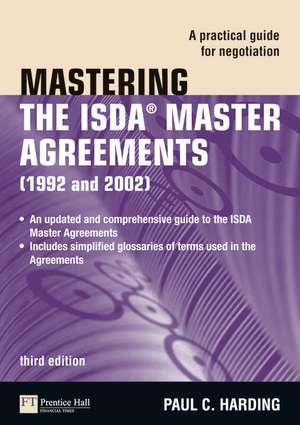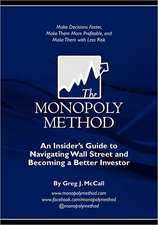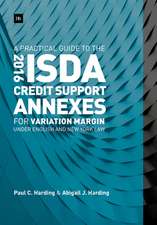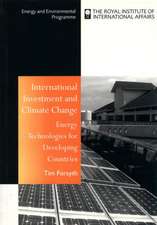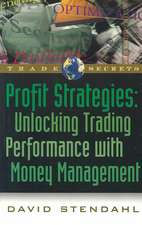Mastering the ISDA Master Agreements (1992 and 2002): A Practical Guide for Negotiation: The Mastering Series
Autor Paul Hardingen Limba Engleză Paperback – 28 apr 2010
The rationale for the new edition is to build on the success of the first two editions. Once again the book will provide the many new entrants globally to derivatives documentation with a practical negotiation guide to both the 1992 and 2002 Agreements so that they can approach their work confidently without the need for constant reference to seniors or regular attendance on training courses.
The ISDA Master Agreement is a complex document and it normally takes 1-2 years for a negotiator to become fully proficient. As well as absorbing the negotiation policies of the institution for which he works, the negotiator also needs to be aware of the implications of possible variations sought by negotiators in other institutions. This book would provide the following:
- a clear, user friendly explanation of the Sections of both Master Agreements
- a sample Schedule describing the reasons for the additions and amendments contained therein
- examples of variations commonly seen in the market and the effects of accepting them
Preț: 944.50 lei
Preț vechi: 1151.82 lei
-18% Nou
Puncte Express: 1417
Preț estimativ în valută:
180.75€ • 188.01$ • 149.22£
180.75€ • 188.01$ • 149.22£
Carte disponibilă
Livrare economică 24 martie-07 aprilie
Livrare express 08-14 martie pentru 62.50 lei
Preluare comenzi: 021 569.72.76
Specificații
ISBN-13: 9780273725206
ISBN-10: 0273725203
Pagini: 804
Ilustrații: figures
Dimensiuni: 165 x 239 x 43 mm
Greutate: 1.34 kg
Ediția:Nouă
Editura: Pearson Education
Seria The Mastering Series
Locul publicării:Harlow, United Kingdom
ISBN-10: 0273725203
Pagini: 804
Ilustrații: figures
Dimensiuni: 165 x 239 x 43 mm
Greutate: 1.34 kg
Ediția:Nouă
Editura: Pearson Education
Seria The Mastering Series
Locul publicării:Harlow, United Kingdom
Descriere
Published by the International Swaps and Derivatives Association, the 1992 and 2002 ISDA® Master Agreements are the main contracts used in the over the counter global derivatives market. Mastering the ISDA Master Agreements provides a practical, clear and useful guide to help understand and negotiate these Master Agreements.
This revised and updated edition is an essential handbook for anyone involved in negotiating agreements, from financial institutions through to fund managers, law firms, credit officers, regulators and business students. The new edition includes:
The book includes:
This revised and updated edition is an essential handbook for anyone involved in negotiating agreements, from financial institutions through to fund managers, law firms, credit officers, regulators and business students. The new edition includes:
- Increased focus on the 2002 ISDA Master Agreement Schedule
- Expanded sections on hedge fund and loan-linked Schedules
- The introduction of covered bonds
- The effect of the credit crunch, the role of derivatives and how this has affected the market
The book includes:
- The evolution of ISDA documentation including general and product definitions and confirmations
- A clear and detailed commentary on the individual sections and provisions of the 1992 and 2002 ISDA Master Agreements
- The main legal issues surrounding the Agreement and OTC derivatives from UK and US legal perspectives
- Special Schedule terms including those for building societies, insurance companies, hedge funds and sovereign entities
- Provisions seen in US Schedules which often face non-US negotiators
- The background to the credit crunch, the effect on the OTC derivatives market and some suggestions about possible changes to the market
- Annexes including reproductions of the ISDA Master Agreements and useful information
- Simplified glossaries of terms used in the Agreements
Cuprins
Chapter 1
Introduction to the global derivatives market (15 pages)
-Size of market according to latest ISDA figures.
-Estimated amount really at risk.
-Main products
-Main currencies.
-Market users.
-How a deal is done from start to finish.
Chapter 2
Need for and evolution of the ISDA Master Agreement (9 pages)
-Inefficiency in documenting each trade in the market's early days.
-Documentation standardisation introduced by ISDA from 1985.
-How ISDA documentation evolved.
-Product Definitions
-Confirmations
-Master Agreement types.
Chapter 3
Section by section clear analysis of the 1992 ISDA Master Agreement (95 pages).
The idea is as before to have a block of ISDA Master Agreement text on one page and a clear explanation of it on the opposite page.
ISDA is willing for Pearson to reproduce the 1992 ISDA Master Agreement in this format provided it pays the USD 5,000 licensing fee referred to in Section 2 above.
Chapter 4
Section by section clear analysis of the 2002 ISDA Master Agreement (200 pages).
Same format.
ISDA is willing for Pearson to reproduce the 2002 ISDA Master Agreement in this format provided it pays the USD 5,000 licensing fee referred to in Section 2 above.
Chapter 5
Legal issues relating to the ISDA Master Agreements (35 pages)
UK issues
-Gaming laws
-Capacity and authority of transacting parties.
-Ultra vires considerations.
-the Hammersmith and Fulham case and local authorities as swaps counterparties.
-Protection from case law and the 1985 Companies Act in the UK.
-specialised entities e.g. insurance companies, pension funds, unit trusts, building societies.
-The concept of suitability.
-Enforceability of close-out netting and set-off.
-Automatic Early Termination.
-The ISDA collective legal opinions.
-Third Party Rights.
New section on US issues
Chapter 6
Credit issues relating to the ISDA Master Agreements (15 pages)
-Addition of Specified Entities.
-Specified Indebtedness variations.
-Downgrade from Cross Default to cross acceleration.
-Threshold Amounts.
-Credit Event Upon Merger variations.
-Additional Termination Events.
-Set Off
-Transfers.
-Political risk.
-The “vanilla ISDA”.
Chapter 7
Operational issues relating to the ISDA Master Agreements (8 pages)
-Confirmations
-Payments
-Deliveries
-Close out
-Administrative matters.
Chapter 8
A sample 1992 ISDA Master Agreement Schedule and accompanying commentary (up to 175 pages).
Chapter 9
A sample 2002 ISDA Master Agreement Schedule and accompanying commentary (up to 30 pages)
In each of these chapters the idea is to have a block of Schedule text on one page and a clear explanation of it on the opposite page.
Chapter 10
Provisions for special entity types and those sought by US counterparties
As per the first edition with some updating. (50 pages). To include new and additional commentary on loan-linked ISDAs, covered bond ISDAs and Hedge fund ISDAs.
Chapters 8, 9 and 10 are the hub of the book because the Schedule is what negotiators actually negotiate and where they need core knowledge and awareness of possible variations and their implications.
Chapter 11 (15 pages)
The effect of the credit crunch on the OTC derivatives market.
Examples of termination letters.
Chapter 12
New developments (5 pages).
Annexes (20 pages)
Introduction to the global derivatives market (15 pages)
-Size of market according to latest ISDA figures.
-Estimated amount really at risk.
-Main products
-Main currencies.
-Market users.
-How a deal is done from start to finish.
Chapter 2
Need for and evolution of the ISDA Master Agreement (9 pages)
-Inefficiency in documenting each trade in the market's early days.
-Documentation standardisation introduced by ISDA from 1985.
-How ISDA documentation evolved.
-Product Definitions
-Confirmations
-Master Agreement types.
Chapter 3
Section by section clear analysis of the 1992 ISDA Master Agreement (95 pages).
The idea is as before to have a block of ISDA Master Agreement text on one page and a clear explanation of it on the opposite page.
ISDA is willing for Pearson to reproduce the 1992 ISDA Master Agreement in this format provided it pays the USD 5,000 licensing fee referred to in Section 2 above.
Chapter 4
Section by section clear analysis of the 2002 ISDA Master Agreement (200 pages).
Same format.
ISDA is willing for Pearson to reproduce the 2002 ISDA Master Agreement in this format provided it pays the USD 5,000 licensing fee referred to in Section 2 above.
Chapter 5
Legal issues relating to the ISDA Master Agreements (35 pages)
UK issues
-Gaming laws
-Capacity and authority of transacting parties.
-Ultra vires considerations.
-the Hammersmith and Fulham case and local authorities as swaps counterparties.
-Protection from case law and the 1985 Companies Act in the UK.
-specialised entities e.g. insurance companies, pension funds, unit trusts, building societies.
-The concept of suitability.
-Enforceability of close-out netting and set-off.
-Automatic Early Termination.
-The ISDA collective legal opinions.
-Third Party Rights.
New section on US issues
Chapter 6
Credit issues relating to the ISDA Master Agreements (15 pages)
-Addition of Specified Entities.
-Specified Indebtedness variations.
-Downgrade from Cross Default to cross acceleration.
-Threshold Amounts.
-Credit Event Upon Merger variations.
-Additional Termination Events.
-Set Off
-Transfers.
-Political risk.
-The “vanilla ISDA”.
Chapter 7
Operational issues relating to the ISDA Master Agreements (8 pages)
-Confirmations
-Payments
-Deliveries
-Close out
-Administrative matters.
Chapter 8
A sample 1992 ISDA Master Agreement Schedule and accompanying commentary (up to 175 pages).
Chapter 9
A sample 2002 ISDA Master Agreement Schedule and accompanying commentary (up to 30 pages)
In each of these chapters the idea is to have a block of Schedule text on one page and a clear explanation of it on the opposite page.
Chapter 10
Provisions for special entity types and those sought by US counterparties
As per the first edition with some updating. (50 pages). To include new and additional commentary on loan-linked ISDAs, covered bond ISDAs and Hedge fund ISDAs.
Chapters 8, 9 and 10 are the hub of the book because the Schedule is what negotiators actually negotiate and where they need core knowledge and awareness of possible variations and their implications.
Chapter 11 (15 pages)
The effect of the credit crunch on the OTC derivatives market.
Examples of termination letters.
Chapter 12
New developments (5 pages).
Annexes (20 pages)
Notă biografică
About the author
Paul Harding is a graduate of London University and has worked in several UK and foreign banks in London in credit, marketing and documentation roles. Since 1990 he has been involved with OTC derivatives documentation and was a well known negotiator in the City of London with Barclays Capital Securities Limited and Hill Samuel Bank Limited where he was head of Treasury Documentation.
In February 1997 he founded Derivatives Documentation Limited (http://www.derivsdocu.com) , a derivatives consultancy and project management company based in the City of London and providing negotiation, recruitment and in-house and on-line training services in derivatives documentation. Its clients include many of the world's leading banks.
Paul is also the author of Mastering Collateral Management and Documentation, written in conjunction with Christian Johnson, which was published in November 2002.
Paul has also written books on ISDA® documentation for credit derivatives and on repos and their master agreement documentation.
Paul Harding is a graduate of London University and has worked in several UK and foreign banks in London in credit, marketing and documentation roles. Since 1990 he has been involved with OTC derivatives documentation and was a well known negotiator in the City of London with Barclays Capital Securities Limited and Hill Samuel Bank Limited where he was head of Treasury Documentation.
In February 1997 he founded Derivatives Documentation Limited (http://www.derivsdocu.com) , a derivatives consultancy and project management company based in the City of London and providing negotiation, recruitment and in-house and on-line training services in derivatives documentation. Its clients include many of the world's leading banks.
Paul is also the author of Mastering Collateral Management and Documentation, written in conjunction with Christian Johnson, which was published in November 2002.
Paul has also written books on ISDA® documentation for credit derivatives and on repos and their master agreement documentation.
Textul de pe ultima copertă
Published by the International Swaps and Derivatives Association, the 1992 and 2002 ISDA(R) Master Agreements are the main contracts used in the over the counter global derivatives market. Mastering the ISDA Master Agreements provides a practical, clear and useful guide to help understand and negotiate these Master Agreements.
This revised and updated edition is an essential handbook for anyone involved in negotiating agreements, from financial institutions through to fund managers, law firms, credit officers, regulators and business students. The new edition includes:
- Increased focus on the 2002 ISDA Master Agreement Schedule
- Expanded sections on hedge fund and loan-linked Schedules
- The introduction of covered bonds
- The effect of the credit crunch, the role of derivatives and how this has affected the market
